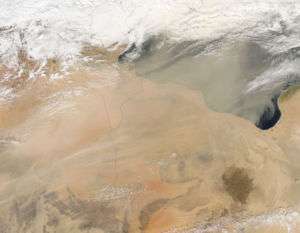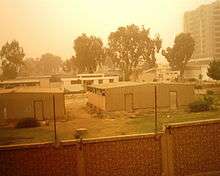Khamsin
Khamsin, chamsin or hamsin (Arabic: خمسين khamsīn, derived from the Arabic word for "fifty"), more commonly known in Egypt as khamaseen (Egyptian Arabic: خماسين khamasīn, IPA: [xæmæˈsiːn]), is a dry, hot, sandy local wind affecting Egypt and Israel; similar winds, blowing in other parts of North Africa, the Arabian Peninsula and the entire Mediterranean basin, have different local names, such as bad-i-sad-o-bist roz in Iran and Afghanistan, haboob in the Sudan, aajej in southern Morocco, ghibli in Tunis, harmattan in the western Maghreb, africo in Italy, sirocco (derived from the Arabic sharkiyya, “easterly”) which blows in winter over much of the Middle East,[1] and simoom.
| Khamsin in hieroglyphs | |||||
|---|---|---|---|---|---|
Resetyu Rstyw The south winds | |||||
 | |||||
From the Arabic word for "fifty", these dry, sand-filled windstorms blow sporadically in Egypt over a fifty-day period in spring, hence the name. The term is also used in the southern Levant (Israel, Palestine, Jordan), where the phenomenon takes a partly different form and blows both during spring and autumn.[1]
When the storm passes over an area, lasting for several hours, it carries great quantities of sand and dust from the deserts, with a speed up to 140 kilometers per hour (87 mph; 76 knots), and the humidity in that area drops below 5%. Even in winter, the temperatures rise above 45° C (113° F) due to the storm. The sand storms are reported to have seriously impeded both Napoleon's military campaigns in Egypt as well as Allied-German fighting in North Africa in World War II.
In the southern Levant it takes the shape of an oppressive weather front with hot temperatures, large quantities of dust impeding visibility, but no strong winds except during the night.[1] In the Book of Exodus of the Hebrew Bible, the ruah kadim or "east wind" is the cause of the parting of the Red Sea (Exodus 14:21).[1]
Causes and history
Khamsin can be triggered by extratropical cyclones that move eastwards along the southern parts of the Mediterranean or along the North African coast from February to June.[2]
In Egypt, the khamsin usually arrives in April but occasionally can occur between March and May, carrying great quantities of sand and dust from the deserts, with a speed up to 140 kilometers per hour, and a rise of temperatures as much as 20 °C (36 °F) in two hours. It is believed to blow "at intervals for about 50 days",[3] although it rarely occurs "more than once a week and lasts for just a few hours at a time."[4] A 19th-century account of the khamsin in Egypt reports that
These winds, though they seldom cause the thermometer of Fahrenheit to rise above 95° in Lower Egypt, or in Upper Egypt 105°, are dreadfully oppressive, even to the natives. When the plague visits Egypt, it is generally in the spring; and the disease is most severe in the period of the khamáseen.[5]
The same account relates that Muslims in Egypt "calculate the period of [khamaseen] ... to commence on the day immediately following the Coptic festival of Easter Sunday, and to terminate on the Day of Pentecost (or Whitsunday); an interval of forty-nine days."[6] This period roughly coincides with the Jewish Counting of the Omer, which also lasts for an interval of 49 days, between the springtime feasts of Passover and Shavuot, the Jewish origins of Easter and Pentecost.
During Napoleon's 1798 Egyptian Campaign, the French soldiers had a hard time with the khamsin: when the storm appeared "as a blood[y] tint in the distant sky", the Ottomans went to take cover, while the French "did not react until it was too late, then choked and fainted in the blinding, suffocating walls of dust."[7] During the North African Campaign in World War II, "Allied and German troops were several times forced to halt in mid-battle because of sandstorms caused by the khamsin... Grains of sand whirled by the wind blinded the soldiers and created electrical disturbances that rendered compasses useless."[8]
In Israel, the khamsin (Hebrew: חמסין) is known more formally as sharav (שרב). [9]
Cultural references

- In the Hebrew Bible, it is called ruaḥ qadīm (רוח קדים) or "east wind",[9] and is considered to be the wind of God.[10]
- Khamsin was the name of a magazine published during the 1970s and 1980s by a group of Israeli Middle Eastern exiles in Europe, including members of Matzpen.[11]
- Khamsin was also the title of a 1982 Israeli film about a clash between a Jewish landowner and his Arab workers in a small farming village in the Galilee.[12] The film was selected by the Israeli Film Board as their nominee for the Academy Award for best foreign-language film in 1983.[13]
- The Alexandria Quartet by Lawrence Durrell also has a vivid description of the Khamsin.
- "Khamsin" is the name of the third movement of the composition Warm Winds, recorded by the Hollywood Saxophone Quartet in the 1950s.
- "Khamsin" was the codename of one of the characters from the video game Metal Gear Rising: Revengeance.
- "Khamsin" was the name of a Flame Haze in the anime, Shakugan no Shana.
- The Maserati Khamsin is a grand tourer produced by Maserati between 1974 and 1982.
- "Khamsin" was the name of the God-like creature in the comic series A Través del Khamsin, published between 2013 and 2016.
- In The Adventures of Tintin, in the volume "Land of Black Gold", Tintin, his dog Snowy and the twin detectives Thomson & Thompson face this storm
- The Khamsin appears as a mythological creature in the Spanish manga from 2013 A Través del Khamsin, published by Norma Editorial and created by Skizocrilian Studio.
References
- Philologos, Fifty Days and Fifty Nights, in The Forward, 4 April 2003. Accessed 18 May 2018
- Giles O.B.E, Bill. "The Khamsin". bbc.co.uk. Retrieved 2008-08-15.
- OED online.
- Humphreys, Andrew (2002). Cairo. Victoria: Lonely Planet. p. 19.
- Lane, Edward William (1973 [1860]). An Account of the Manners and Customs of the Modern Egyptians. With a new introduction by John Manchip White. New York: Dover Publications. p. 2.
- Lane, p. 488.
- Burleigh, Nina (2007), Mirage, New York, Harper, p. 135.
- DeBlieu, Jan (1998), Wind, New York, Houghton Mifflin, p. 57.
- Philologos (April 4, 2003). "Fifty Days and Fifty Nights". JewishForward.com. Archived from the original on 2007-04-26. Retrieved 2007-02-26.
- Edward Reaugh Smith (2003). The Soul's Long Journey: How the Bible Reveals Reincarnation. SteinerBooks. p. 201. ISBN 978-0-88010-535-4.
- "Khamsin". Matzpen. Archived from the original on 2014-02-19. Retrieved 2008-08-15.
- Kronish, Amy. "Arabs on Israeli Screens". Archived from the original on 2007-01-26. Retrieved 2007-02-26.
- "Oscar Film Critical of Israel". The New York Times. January 24, 1983. Retrieved 2007-02-26.
External links
| Wikimedia Commons has media related to Khamsin. |